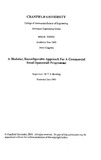JavaScript is disabled for your browser. Some features of this site may not work without it.
| dc.contributor.advisor | Bowling, Tom | |
| dc.contributor.author | Kingston, Jenny | |
| dc.date.accessioned | 2009-10-30T12:45:59Z | |
| dc.date.available | 2009-10-30T12:45:59Z | |
| dc.date.issued | 2003-06 | |
| dc.identifier.uri | http://hdl.handle.net/1826/3904 | |
| dc.description.abstract | This thesis presents the work performed in producing a system-level design for a modular, multipurpose small satellite platform. A multipurpose platform may be applied to a wide range of missions, and, to be commercially viable, the envelope of missions for which it is suitable should be as large as possible. The research therefore addresses the particular requirements that are specific to different mission types, and produces characteristic requirement sets for each. General design requirements are also derived, such as those for enabling modularity and allowing compatibility with different launch vehicles. The commercial requirements arising from the different market and customer sectors are also examined. Industry analysis allows identification of general market trends, and predictions are made regarding the likely size and characteristics of the market in which the proposed platform would compete. It is anticipated there could be a worldwide demand for more than twenty small satellites each year, for which a flexible small spacecraft platform could potentially compete. After derivation of the necessary requirements has been performed, a system-level design of the spacecraft platform is undertaken. The resulting design is based on a multi-module, reconfigurable concept, which can be adapted to fit the different launch envelopes of Pegasus-XL, Taurus, ASAP-5 and larger launchers, and also to accommodate a wide range of payloads. The subsystems are offered in different capability variants, which may be interchanged in response to different mission requirements. The platform equipment and structure forms a "standard parts lisf', from which the appropriate configuration can be built up. Schedule reductions are obtained due to the modular design allowing more of the integration and testing of the platform to be performed in parallel. The proposed programme for development of the platform uses up-front investment to conduct much of the detailed design of the platform in advance of any actual project. This allows the design effort to be shared across many subsequent projects, and the design phase of each new project to be minimised. The key benefits of the proposed platform and programme are adaptability, ability to rapidly reconfigure to mission requirements, suitability for future upgrading, and reduction of the project schedule. | en_UK |
| dc.language.iso | en | en_UK |
| dc.publisher | Cranfield University | en_UK |
| dc.title | Modular, reconfigurable approach for a commercial space spacecraft programme | en_UK |
| dc.type | Thesis or dissertation | en_UK |
| dc.type.qualificationlevel | Doctoral | en_UK |
| dc.type.qualificationname | EngD | en_UK |
